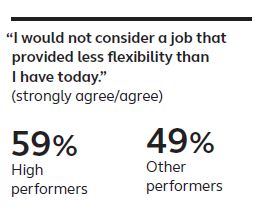As an HR professional, you don’t have time to mourn the loss of a perfectly fitting candidate. You’re expected to brush off your professional ego and quickly move on to find and hire more top talent.
The trouble is, the risk of rejection hasn’t diminished in spite of company culture overloads, massive branding efforts, changes in flexibility, and depleted hiring budgets. The good news is candidates are speaking up about what they will — or will not — accept when it comes to their careers.
You only establish control over your job offers once you recognize where job seekers demand improvement. Here are three reasons why candidates are saying no to job offers:
Not enough flexibility
Companies have been pushing for more flexibility to entice candidates and retain employees for years. Unfortunately, this has opened a new competitive space. Job seekers won’t settle for anything less than the flexibility they’ve grown accustomed to.
In fact, 59% of high-performing respondents said they wouldn’t even consider a job with less flexibility than they currently have, according to Alight’s 2018 Workforce Mindset Study.
Job seekers no longer view working from home one day a week or flexible working hours as impressive benefits. They’re looking for a wide variety of flexibility options, such as:
- Unconventional hours

- The ability to adapt
- Location variety
- Location independence
- Minimum travel
- Reduced workloads when needed
Make your flexibility offerings count. A simple but effective place to start is adding a discussion about location variety as an option for all your roles. In fact, 84% of respondents in the Alight report say that’s exactly what they’re looking for from employers.
Remember, this goes beyond ensuring employees have the tools to work from home. Those craving location variety want the freedom to work from anywhere, allowing them to design the unique lifestyle they desire.
You think fair pay is enough
“Competitive pay”: It’s one of the most frequently noted aspects listed in job postings. Of course, employees are looking for career opportunities that provide them with high earning potential, but this doesn’t mean it’s an award-winning perk.
Job seekers see competitive pay as a standard. They expect fair compensation and have the power to research and demand the average figure companies should offer them. While 43% of employees already feel their rewards are on par with all other companies, according to the above Alight report, focusing on competitive pay as a per’ could leave them underwhelmed and unmoved when it comes to making a decision on your job offer.
Focus, instead, on your benefits as a whole entity. Competitive pay is certainly part of this but it shouldn’t stand alone. Pair it with the company’s wellness offerings, healthcare benefits, flexibility options, and even bonus possibilities to maximize employees’ collective earning potential.
Look at your benefits and determine what is essential, what makes employees’ lives easier, and what is just nice to have. Sufficient salary and health insurance, for example, should fall in the “given” category when making an offer, whereas a Starbucks discount card or company laptop are perks. You will really make that difference stand out over competitors if you allow your candidates to customize their benefits and perks packages per their individual needs and desires.
Ineffective communication
Most job seekers aren’t out there chasing a few far-fetched pipe dreams. They’re looking for companies with realistic opportunities in an environment where they can have a hand in making positive changes. It is only possible if communication is effective.
Once candidates have reached the final stages of the hiring process and are offered a job, they should already have an idea of the company’s communication efforts. Candidates are analyzing communication efforts and effectiveness from the moment they send a LinkedIn connection request.
Use this to your advantage and give candidates the opportunity to witness company communications. Show them examples of employee newsletters, chat rooms with both employees and company leaders, and other unique ways the company keeps employee communications open and honest.
Be especially conscious of the amount of time it takes you to respond to candidates. If your schedule only allows you to sit and answer questions on certain days of the week or certain hours of the day, openly communicate that schedule. Also, consider making the communication more personal for candidates by responding to their questions with short, 90 second, videos.
